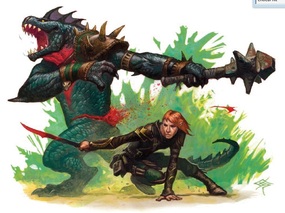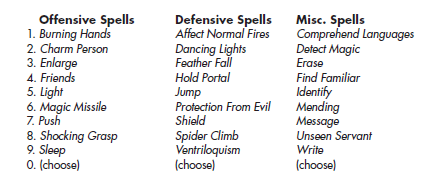Here is my revised B/X weapon list.
The goals is to make it simpler (fewer words/entries, also clearer), expanded (more weapons), more balanced (no useless or flawless weapons), varied (distinctions between weapons) and easier to use (pick your weapon size/style before choosing a particular weapon). Weights are a bit more sensible but not entirely realistic.
This is somewhat similar to
Dark Fantasy Basic, but adapted to B/X. It also incorporate some
AD&Disms such as speed, reach, defeating armor, and damage against large creatures, but keeps them extremely simplified.
 |
| Two-handed mace is needed! |
|
Melee weapon
|
Price
|
Weight
|
Dmg.
|
Range
|
|
Dagger
|
3
|
10
|
1d4
|
10
|
|
Small/short
weapon
|
6
|
30
|
1d6
|
10
|
|
Medium
weapon
|
10
|
50
|
1d8
|
-
|
|
Large/Great
weapon
|
20
|
80
|
1d10
|
-
|
|
Polearm
|
30
|
120
|
1d10
|
-
|
|
|
|
|
|
|
Ranged weapon
|
Price
|
Weight
|
Dmg.
|
Range
|
|
Sling
|
2
|
10
|
1d4
|
50
|
|
Short bow
|
20
|
30
|
1d6
|
50
|
|
Long bow
|
30
|
40
|
1d6
|
70
|
|
Crossbow
|
40
|
50
|
1d6
|
80
|
Small weapons are one-handed, and can be used in the off-hand too (except spears). Medium weapons are one-handed, but can be held with two (+1 damage). Large weapons require two hands.
----
CLASSES
Clerics can only use blunt weapons: hammers, maces, clubs, some polearms, slings. Mages can use daggers and staves (optional: can use other weapons, -4 to hit). Dwarves and halflings need two hands to use medium weapons (no bonus damage) and cannot use large ones (or longbows).
---
WEAPON TYPES
Every melee weapon can be taken in small, medium, or large size unless indicate otherwise.
Axes, hammers, maces deal +1 damage on a natural 20 in melee (but not thrown). They are also good at breaking down doors, etc.
Clubs are cheap (1 sp) medium weapons that deal 1d4 damage.
Crossbows need one round to recharge after fired and deal +1 damage on a natural 20.
Javelins are cheap (1 gp) small spears that can be thrown (90') but not used in melee for more than one single hit (as they may bend when they hit).
Lances are just heavy spears made to be used one-handed when riding a horse (1d6 damage). They deal double damage on a charge.
Picks get +1 to-hit against heavy armor (chain or better), unless the opponent is large. A pick can be added to a axe/hammer/mace for 5 gp.
Polearms are "combination" weapons - either a sword on top of a long pole (naginata/halberd/etc. - +1 damage against large foes AND +1 on a critical 20), or a combination of one or two other large weapons (spear and hammer, hammer and axe, pick and axe, etc.). They are always as long as large spears and if they include a spear they can be used to brace against a charge (1d8).
Spears are cheaper (half price), lighter (-10 weight) and deal less damage (1d4, 1d6, 1d8), but can be thrown (60'). Large spears cannot be thrown, but are very long. Medium and large spears deal double damage when bracing against a charge.
Staves (e.g., quarterstaff) are cheap (2 sp), light (40) large weapons that deal 1d6 damage.
Swords deal +1 damage against large enemies; they cannot be thrown.
Fencing swords are medium, weight 40, cost 15, can only be used one-handed, and have no benefit against large foes, but get +1 to-hit against unarmored targets.
---
HOUSE RULES
Critical hits (on a natural 20): +2 damage; +4 for large weapons (+3/+5 for certain weapons as seen above).
Initiative: on ties, when both sides are attacking, the weapons will indicate who attacks first. If you are not engaged with your foe, the longest (or better range) weapon attacks first. If you are already engaged, the quickest weapon attacks first.
[For now, it is up to the GM to decide which is which, but should be obvious most of the time - larger weapons are longer and slower, and within the same size axes and maces are shorter and slower while spears are the opposite. A polearm is always slower].
(Thanks again Sleeper for the idea).
Dual wielding: if holding one weapon in each hand, you can make an attack with the other weapon when you roll a natural 2. On initiative ties, you choose which weapon to use. If holding two identical weapons (e.g., two shortswords), they are considered both faster and longer against an opponent using a single identical weapon (shortsword).
Range: you can double the maximum range (-2 penalty) or triple it (-3 penalty), but not more.
---
NOTES:
I'll try to add Speed Factor the next time around. But TBH this looks pretty good for my own games.
Oil flasks and holy water have special rules and do not belong in this list IMO. A torch is not a weapon and should deal maybe 1d2 damage at most, unless combined with an oil flask or something. The "slow" tag is discarded as it doesn't accomplish anything IMO.
And let me know if I missed anything!










